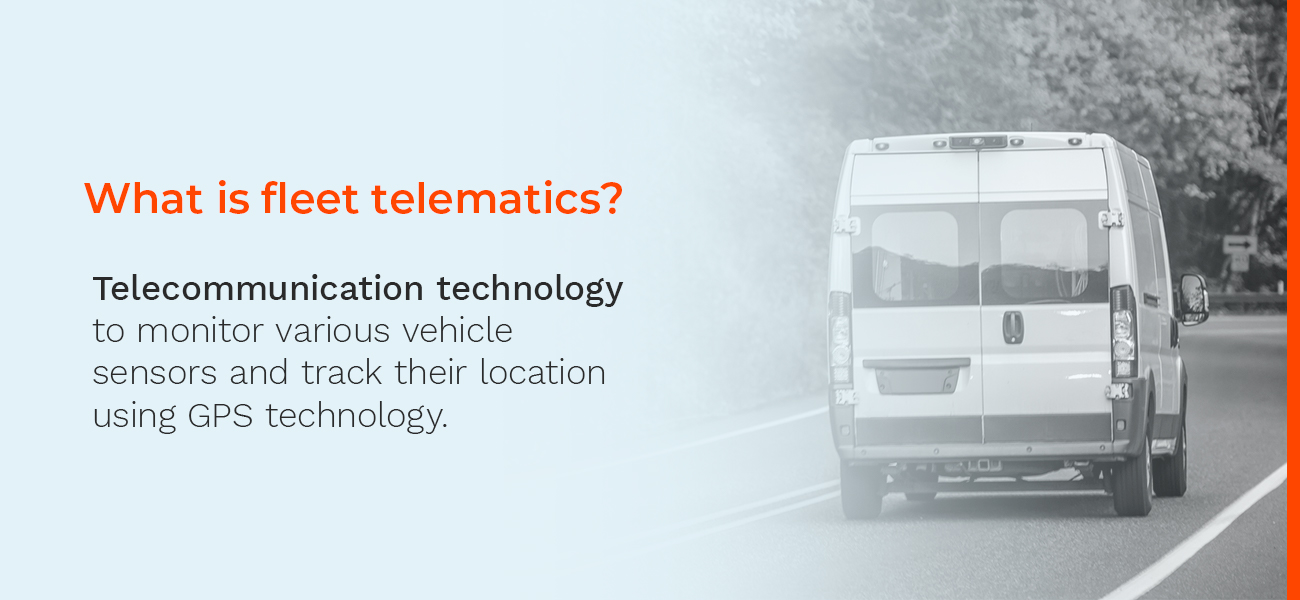What is Telematics? | Benefits of Telematics for Fleets
During the 1960s, the U.S. military saw the benefits of combining telecommunications technology with information technology and processing. The blending of these technologies was called telematics.
Telematics involves gathering data from various sensors and gauges, recording it on a device, and then using telecommunication or cellular networks to transmit that data to a server or computer. From there, the information can be used in a wide variety of applications.
Vehicle sensors generate an impressive amount of useful information, but until telematics was invented, that information remained recorded and largely unused onboard the vehicle’s data storage unit. Typically, mechanics were the only ones who accessed this information through the OBDII or CAN-BUS port to diagnose a check engine light and resolve a problem.
By using vehicle sensors and combining many other sensors, including GPS trackers and accelerometers, computer hardware can then connect to a cellular network using 3G, 4G, and LTE communications. This way, it can transmit data to a server or computer where the information can be made useful.
Once the data is collected on a computer, it can display everything from engine diagnostics to vehicle speed, location, acceleration, and braking patterns in real time. This allows for an impressive level of control and feedback from an entire fleet.

By using telecommunication technology to monitor various vehicle sensors and track their location using GPS technology, managers can paint a much better picture of their vehicle fleet activities.
Vehicle maintenance can be automatically scheduled based on odometer readings, and repairs can be arranged immediately after a sensor detects a problem with a vehicle. Real-time detection means mechanical issues don't persist and are dealt with immediately, preventing major mechanical problems from occurring later on.
Telematics systems also log fuel consumption, idle habits, and fuel waste by analyzing fleet data and generating reports. This information can save vast amounts of money on fuel costs and reduce CO2 emissions to lighten fleet vehicles’ environmental burden.
When vehicle speed and additional accelerometer data that is capable of detecting acceleration and braking habits is relayed and compiled in useful ways, it’s easy for managers to determine whether their drivers are driving unsafely. Managers can then take actions to correct the issues, such as enrolling workers in driver safety courses. Insurance companies are even starting to give rebates to companies that can demonstrate their safe driving habits.
If an accident occurs, vehicle telematics data can exonerate innocent drivers. Dash cams and sensors record the surroundings and provide a detailed account of events during an accident. These same devices can also record incidences of vandalism and property damage.
Equipment such as tractor-trailers and shipping containers can even be equipped with GPS trackers, allowing them to remain accounted for in real time. The software can alert the user if specific equipment is being moved when it shouldn't be. Machinery can also be tracked if theft occurs. This is a significant organizational improvement over the logbooks and journal record-keeping of yesterday.
How fleet telematics works

Your vehicle uses many sensors to ensure regular operation, such as emission, fuel flow, temperature, and vibration sensors. These are all logged in the vehicle’s Controller Area Network (CAN). The CAN then analyzes the data and determines if any of it is outside of its required range.
When this happens, the CAN will adjust things like timing, voltage, position, or temperature through the many Electronic Control Units (ECUs) throughout the vehicle. If the vehicle’s electronic systems cannot remedy the situation, the check engine light will illuminate on the dash.
Many telematics devices can either store vehicle data onboard or transmit the information through a cellular network. Many of these appliances come with GPS technology and other sensors to provide additional information not typically recorded by the vehicle sensors. Data transmitted through a cellular network is then collected on a server and routed to the user's computer. The user can then have the data analyzed to provide useful insights into driver habits, vehicle performance, and technical issues.
Telematics as part of fleet management
Telematics has been widely integrated into an array of hardware and software solutions tailored to organizing and improving fleet vehicle operations. Logistics, safety, and reliability have become the core focus of improving telematic systems, but they also offer many benefits to fleet vehicles and their drivers.
Managers can use telematics systems to map fleet vehicles in real time and optimize their pickup and delivery schedules over a wide area. Businesses like taxi companies no longer have to rely solely on radios and maps to direct their drivers to clients. Instead, they can select drivers closest to the pickup location. This dramatically increases service to customers and reduces overall vehicle idle time, saving fuel and reducing negative environmental impact.
Maintenance schedules and mechanical repairs can integrate into telematics systems to minimize vehicle downtime and reduce instances of mechanical failure. This results in savings on lifetime vehicle repair costs, tow bills, and driver downtime.
With government organizations such as the Federal Motor Carrier Safety Administration (FMCSA) requiring hours-of-service (HOS) logs to ensure drivers are taking sufficient breaks during long-haul trips, telematics provides a convenient software solution that automatically tracks the miles driven, locations, and driver time behind the wheel. These logs can ensure drivers are operating their vehicles safely and under Department of Transportation (DOT) compliance and pardon the driver if an accident happens.
How can telematics help your fleet?
.jpg?width=1300&height=600&name=04-Putting-them-all-together_(1).jpg)
Why use fleet telematics? The benefits of telematics just with a single vehicle are evident. Maintenance schedules are easier to follow, driving habits are quickly identified, and logistics are greatly optimized. The most considerable advantages are seen when telematics technology is integrated into an entire fleet of vehicles.
Driver profiles can be generated and used to determine which drivers are better suited to drive which vehicles or operate in certain parts of town. Some drivers are more comfortable driving in the city while others prefer the freeway. Vehicle telematics data and software integration can identify these profiles and make driver management easier and more efficient.
Vehicle maintenance can be achieved in a bulk method where multiple vehicles might need the same service. This can lead to cheaper maintenance costs and better relationships with automotive service providers. You also get an added safety benefit in ensuring all your fleet vehicles’ services are up to date and all vehicles are operating correctly.
The logistic benefits of telematics are significant — every vehicle can be monitored in real time on a map. Deliveries and pickups can be seamlessly scheduled together to massively improve driver efficiency and reduce fuel costs and vehicle maintenance. Customers will receive tremendous benefits as they can rely on the extremely efficient logistics telematics systems.
Benefits of Telematics for Fleets
Here's a more detailed look at the advantages of telematics for fleets:
1. Productivity and automation
With vehicle monitoring coming to you in real time, you can resolve mechanical problems as they occur. In the past, fleet vehicles have been notoriously neglected by drivers because of the lack of ownership over any one vehicle, as drivers tend to change automobiles daily. With instant access to vehicle statistics, acute mechanical issues can be remedied immediately.
Maintenance schedules are easier to adhere to as well. They don't require drivers to constantly update logbooks with odometer readings. Long-term maintenance services, such as tire changes, brake services, and clutch replacements, can be implemented as software alerts. These tools enable a fleet of vehicles to operate seamlessly and ensure driver schedules are always maintained. Never again will companies face multiple fleet vehicles undergoing major mechanical repairs due to maintenance neglect, as these issues can be resolved immediately before they become larger problems.
If a vehicle does break down, telematics can alert tow and vehicle service companies immediately and dispatch them to fix issues. This means drivers are no longer stranded on the side of the road, wondering if they should call a tow truck or attempt to resolve the problem themselves. The proactivity of telematics systems gives vehicle fleets unparalleled productivity and maintenance automation never before achievable using conventional log keeping systems and communication tools.
2. Safety
When drivers know their behaviors are being recorded and reported to their manager in real time, this accountability causes them to drive with greater caution. When they know their manager can monitor their vehicle movement and even access dash cams to observe congested traffic, they will feel inclined to drive more safely because their manager will understand traffic congestion is causing delays.
Telematics also offers a host of services if a vehicle is involved in an accident. Dash cams record and relay video footage that can clear drivers of fault and help reconstruct accidents to prove the driver is innocent. These recordings provide massive support with insurance coverage disputes or rate increases.
In-vehicle driver coaching is another tool managers can use to ensure drivers are adequately trained and remain up to date on the latest safe driving practices. Vehicle operation can be recorded to an amazing level of detail and can clearly show if a driver is handling the vehicle incorrectly. Driving mistakes can then be improved, resulting in safer vehicle operation and more highly competent driver skill.
3. Compliance
The FMCSA mandates that all drivers operating motor vehicles adhere to their hours-of-service protocol, ensuring they are always alert behind the wheel. These rules help reduce the number of accidents per year and ensure safer roads for everyone.
With hardware and software integration providing organized and easily verifiable logs to drivers, managers, and authorities, it’s easier than ever to meet the FMCSA requirements. Many telematics devices alert users to mandatory driving breaks and their total elapsed time behind the wheel since they began their trip. These convenient tools ensure drivers and managers fully control their trip planning and integrate breaks into their logistic operations.
4. Visibility
Camera and sensor technology gives fleet vehicles as much surveillance and security as is desired. Managers can access cameras to determine driver location and local traffic congestion. When managers oversee many fleet vehicles, real-time map location and vehicle tracking can make logistics and customer service effortless. Changes to delivery and pickup services can be made instantaneously without compromising other customers' expectations.
In an accident, the camera recordings and sensor data are easily accessible to provide an accurate, visible picture of what happened. This can help persuade an insurance company to settle disputes in your favor.
5. Maintenance
Fleet vehicles have a record of being neglected. This is not because drivers don't care for their vehicles, but because they’re often rotated between different ones. Conventional maintenance schedules rely on accurate record-keeping, which tends to be disregarded due to everyday business operation stresses. These problems often leave fleet vehicles neglected, leading to more severe issues later on. If mechanical issues are left unfixed for long enough, they can even lead to vehicle breakdowns, which seriously impact business operations and result in huge tow and repair bills.
Telematics systems and their software solutions come with a truly impressive array of automatic record-keeping and maintenance alert tools to ensure fleet vehicles remain up to date in their mechanical service. Software systems alert managers immediately to mechanical problems, even if they are not aware anything is wrong and the check engine light is not illuminated.
6. Fuel efficiency
Optimizing logistical operations is the basis for providing unparalleled customer service and saving driver time and fuel costs. Telematics systems allow managers to organize driver operations to ensure they are traveling the most efficient routes. This means avoiding areas of high traffic congestion or accident backups. When driver routes are optimized, fleet vehicles burn far less fuel.
Maintaining maintenance schedules, such as changing fuel filters, spark plugs, and air filters, is critical to conserving fuel. If these items are left unmaintained, they can drastically reduce fuel efficiency and add additional load on other mechanical systems. This can potentially result in mechanical failure later on. Telematics systems make following a maintenance schedule seamless, ensuring fuel efficiency will always remain as high as possible.
Managers can also observe their fleet vehicles’ idle statistics as drivers are on the road. This means they know when a vehicle is running without movement and wasting fuel. Managers can then take appropriate measures, such as rerouting drivers through less traffic-congested areas to reduce idle time and improve fuel efficiency. This saves money and can even reduce adverse environmental effects.
7. Customer service
vLogistics have become a cornerstone in our modern economy. Millions of people worldwide rely on products and services to be delivered on time and on budget every day to operate their businesses effectively. Customers are more willing than ever to switch to other suppliers or services that offer more reliable delivery or pickup processes because numerous options are available. This is why telematic services are critical. They enable companies to employ the most state-of-the-art logistical operations to ensure their customers get the service they rely on.
Drivers also benefit immensely from telematics services. Options like GPS mapping, dash cameras, and mechanical diagnostics make their driving activities much more efficient and manageable. Knowing their manager is aware of their location relieves stress and allows them to focus on the road and drive more safely. When they arrive at their location on time, the customer will be thankful and more likely to have a positive interaction with the driver, which is a win-win situation for any business.
8. Savings
The savings realized with telematics systems are enormous. Optimizing fleet logistics enables vehicles to drive fewer overall miles to meet their traveling needs. It ensures products and services are delivered on time, which clients appreciate. This can make them more inclined to become repeat customers.
Maintenance programs allow fleet vehicles to adhere to an intelligent schedule determined by odometer readings, which means services like filter changes, brake pad replacements, and fluid flushes are performed as the vehicle manufacturer intends. The result is a longer service life with fewer acute mechanical issues and associated towing and downtime expenses.
Telematics allows managers to track the time drivers spend at the wheel, allowing for more accurate payroll calculations. This is especially beneficial for long-haul truckers driving at an hourly rate.
Fuel mileage can significantly increase by optimizing vehicle travel to avoid areas of traffic congestion. Additionally, real-time GPS technology allows managers to see if drivers are taking unwarranted breaks or making unscheduled stops. Then, managers can take action to reduce overall fuel consumption and save more money.
Choose Rand McNally Fleet telematics solutions
The benefits of telematics solutions are huge. The combination of vehicle diagnostics, GPS technology, and network communication presents managers with a real-time picture of their fleet operations. They are better assisted in making decisions that improve their operational efficiency and provide their customers with seamless service.
Drivers benefit from several products that assist them in their daily driving, including GPS mapping tools, vehicle diagnostics, and assistance tools. They stay connected with their managers through devices that keep them on schedule and help them provide excellent customer service.
Rand McNally is an industry leader in telematics solutions, providing a wide array of software and hardware systems that can improve any fleet's efficiency and safety. We provide uniquely tailored solutions for any fleet, from logistics and delivery services to moving and transit enterprises. For more information on our telematics solutions, contact us for pricing information today.
Contact Rand McNally
Request Pricing for Fleet Solutions
We're looking forward to talking with you. Please fill out the form to get started.
Or call us:
+1 (800) 789-6277 (Fleet management, ELD, Asset tracking, Navigation)
+1 (800) 234-4069 x2 (MileMaker/IntelliRoute)
If you are an existing customer and need assistance, please contact your Client Success rep or email fleetsupport@randmcnally.com.
This form is for business-to-business transactions only. It is not for personal consumer use.


